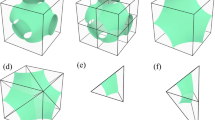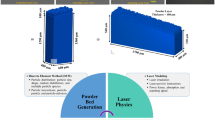Abstract
Our objective is to determine the optimal undeformed workpiece geometry (material configuration) within forming processes when the prescribed deformed geometry (spatial configuration) is given. For solving the resulting shape optimization problem—also denoted as inverse form finding—we use a novel parameter-free approach, which relocates in each iteration the material nodal positions as design variables. The spatial nodal positions computed by an elasto-plastic finite element (FE) forming simulation are compared with their prescribed values. The objective function expresses a least-squares summation of the differences between the computed and the prescribed nodal positions. Here, a recently developed shape optimization approach (Landkammer and Steinmann in Comput Mech 57(2):169–191, 2016) is investigated with a view to enhance its stability and efficiency. Motivated by nonlinear optimization theory a detailed justification of the algorithm is given. Furthermore, a classification according to shape changing design, fixed and controlled nodal coordinates is introduced. Two examples with large elasto-plastic strains demonstrate that using a superconvergent patch recovery technique instead of a least-squares (\(L^{2}\))-smoothing improves the efficiency. Updating the interior discretization nodes by solving a fictitious elastic problem also reduces the number of required FE iterations and avoids severe mesh distortions. Furthermore, the impact of the inclusion of the second deformation gradient in the Hessian of the Quasi-Newton approach is analyzed. Inverse form finding is a crucial issue in metal forming applications. As a special feature, the approach is designed to be coupled in a non-invasive fashion to arbitrary FE software.
Access this article
We’re sorry, something doesn't seem to be working properly.
Please try refreshing the page. If that doesn't work, please contact support so we can address the problem.

















Similar content being viewed by others
References
Acharjee S, Zabras N (2006) The continuum sensitivity method for computational design of three-dimensional deformation processes. Comput Methods Appl Mech Eng 195:6822–6842
Apel N (2014) Approaches to the description of anisotropic material behaviour at finite elastic and plastic deformations: theory and numerics. Ph.D. Thesis, Universitt of Stuttgart, Institut für Mechanik (Bauwesen) Lehrstuhl I
Ask A, Denzer R, Menzel A, Ristinmaa M (2013) Inverse-motion-based form finding for quasi-incompressible finite electroelasticity. Int J Numer Methods Eng 94(6):554–572
Braibant V, Fleury C (1984) Shape optimal design using B-splines. Comput Methods Appl Mech Eng 44(3):247–267
Chenot J, Bernacki M, Bouchard P, Fourment L, Hachem E, Perchat E (2014) Recent and future developments in finite element metal forming simulation. In: Ishikawa T, Mori K (eds) 11th international conference on technology of plasticity. Nagoya, pp 1–22
Chenot J, Massoni E, Fourment L (1996) Inverse problems in finite element simulation of metal forming processes. Eng Comput 13(2–4):190–225
Firl M, Wuechner R, Bletzinger K (2013) Regularization of shape optimization problems using FE-based parametrization. Struct Multidiscip Optim 47:507–521
Fourment L, Balan T, Chenot J (1996) Optimal design for non-steady-state metal forming processes—II. Application of shape optimization in forging. Int J Numer Methods Eng 39:51–65
Germain S (2013) On inverse form finding for aniostropic materials in the logarithmic strain space. In: Schriftenreihe Technische Mechanik - Band 8, Friedrich-Alexander-Universität Erlangen-Nürnberg, Lehrstuhl für Technische Mechanik
Germain S, Landkammer P, Steinmann P (2013) On a recursive formulation for solving inverse form finding problems in isotropic elastoplasticity. Adv Model Simul Eng Sci 1(10):1–19
Govindjee S, Mihalic P (1996) Computational methods for inverse finite elastostatics. Comput Methods Appl Mech Eng 136:47–57
Govindjee S, Mihalic P (1998) Computational methods for inverse deformations in quasi incompressible finite elasticity. Int J Numer Methods Eng 43:821–838
Guo Y, Batoz J, Naceur H, Bouabdallah S, Mercier F, Barlet O (2000) Recent developments on the analysis and optimum design of sheet metal forming parts using a simplified inverse approach. Comput Struct 78(1–3):133–148
Haftka R, Grandhi R (1986) Structural shape optimization—a survey. Comput Methods Appl Mech Eng 57(1):91–106
Herrmann L (1976) Laplacian-isoparametric grid generation scheme. J Eng Mech Div 102(5):749–756
Hill R (1948) A theory of the yielding and plastic flow of anisotropic metals. Proc R Soc A Math Phys Eng Sci 193(1033):281–297
Hinton E, Campbell J (1974) Local and global smoothing of discontinuous finite element functions using a least squares method. Int J Numer Methods Eng 8(3):461–480
Kim J, Kim N, Huh M (2000) Optimum blank design of an automobile sub-frame. J Mater Process Technol 101:31–43
Kim N, Choi K, Chen J, Park Y (2000) Meshless shape design sensitivity analysis and optimization for contact problem with friction. Comput Mech 25:157–168
Kleinermann J, Ponthot J (2003) Parameter identification and shape/process optimization in metal forming simulation. J Mater Process Technol 139(1–3):521–526
Landkammer P, Loderer A, Krebs E, Söhngen B, Steinmann P, Hausotte T, Kersting P, Biermann D, Willner K (2015) Experimental verification of a benchmark forming simulation. Key Eng Mater 639:251–258
Landkammer P, Schulte R, Steinmann P, Merklein M (2016) A non-invasive form finding methods with application to metal forming. Prod Eng 10(1):93–102
Landkammer P, Söhngen B, Steinmann P, Willner K (2017) On gradient-based optimization strategies for inverse problems in metal forming. GAMM-Mitteilungen (accepted)
Landkammer P, Steinmann P (2016) A non-invasive heuristic approach to shape optimization. Comput Mech 57(2):169–191
Le C, Bruns T, Tortorelli D (2011) A gradient-based, parameter-free approach to shape optimization. Comput Methods Appl Mech Eng 200(9–12):985–996
Lee C, Huh H (1998) Three dimensional multi-step inverse analysis for the optimum blank design in sheet metal forming processes. J Mater Process Technol 80–81:76–82
Michaleris P, Tortorelli D, Vidal C (1994) Tangent operators and design sensitivity formulations for transient nonlinear coupled problems with applications to elastoplasticty. Int J Numer Methods Eng 37(14):2471–2499
Naceur H, Delameziere A, Batoz J, Guo YQ, Knopf-Lenoir C (2004) Some improvements on the optimum process design in deep drawing using the inverse approach. J Mater Process Technol. doi:10.1016/j.matprotec.2003.11.015
Nocedal J, Wright S (2006) Numerical optimization. Springer, New York
Padmanabhan R, Oliveira M, Baptista A, Alves J, Menezes L (2009) Blank design for deep drawing parts using parametric nurbs surfaces. J Mater Process Technol 209(5–6):2402–2411
Park M, Suh Y, Song S (2012) On an implementation of the strain gradient plasticity with linear finite elements and reduced integration. Finite Elem Anal Des 59:35–43
Park S, Yoon J, Yang D, Kim Y (1999) Optimum blank design in sheet metal forming by the deformation path iteration method. Int J Mech Sci 41(10):1217–1232. doi:10.1016/s0020-7403(98)00084-8
Scherer M (2011) Regularizing constraints for mesh and shape optimization problems. Schriftenreihe Technische Mechanik - Band 5, Friedrich-Alexander-Universität Erlangen-Nürnberg, Lehrstuhl für Technische Mechanik
Scherer M, Denzer R, Steinmann P (2009) A fictitious energy approach for shape optimization. Int J Numer Methods Eng 82:269–302. doi:10.1002/nme.2764
Schmitt O, Friederich J, Riehl S, Steinmann P (2015) On the formulation and implementation of geometric and manufacturing constraints in node-based shape optimization. Struct Multidiscip Optim 53(4):881–892. doi:10.1007/s00158-016-1595-y
Sellier M (2005) Fixed point iterative schemes for initial shape identification. Tech Mech 25(3–4):208–217
Steinmann P (1997) Modellierung und Numerik duktiler kristalliner Werkstoffe. Habilitationsschrift, Forschungs- und Seminarberichte aus dem Bereich der Mechanik der Universität Hannover, F 97/1, Univeristät Hannover
Steinmann P (2015) Geometrical foundations of continuum mechanics. Springer, Heidelberg
Stupkiewicz S, Lengiewicz J, Korelc J (2010) Sensitivity analysis for frictional contact problems in the augmented langrangian formulation. Comput Methods Appl Mech Eng 199:2165–2176
Tortorelli D, Michaleris P (1994) Design sensitivity analysis: overview and review. Inverse Probl Eng 1(1):71–105
Wallin M, Ristinmaa M (2015) Topology optimization utilizing inverse motion based form finding. Comput Methods Appl Mech Eng 289:316–331
Yao T, Choi K (1989) 3-D shape optimal design and automatic finite element regridding. Int J Numer Methods Eng 28:369–384
Zienkiewicz O, Zhu J (1992) The superconvergent patch recovery and a posteriori error estimates. Part 1: the recovery technique. Int J Numer Methods Eng 33(7):1331–1364
Acknowledgements
This work is part of the collaborative research project Manufacturing of complex functional components with variants by using a new metal forming process—Sheet-Bulk Metal Forming (SFB/TR73: www.tr-73.de).
Author information
Authors and Affiliations
Corresponding author
Rights and permissions
About this article
Cite this article
Landkammer, P., Caspari, M. & Steinmann, P. Improvements on a non-invasive, parameter-free approach to inverse form finding. Comput Mech 61, 433–447 (2018). https://doi.org/10.1007/s00466-017-1468-2
Received:
Accepted:
Published:
Issue Date:
DOI: https://doi.org/10.1007/s00466-017-1468-2




